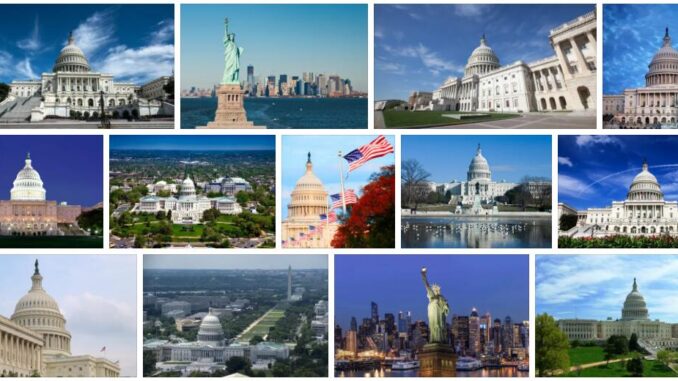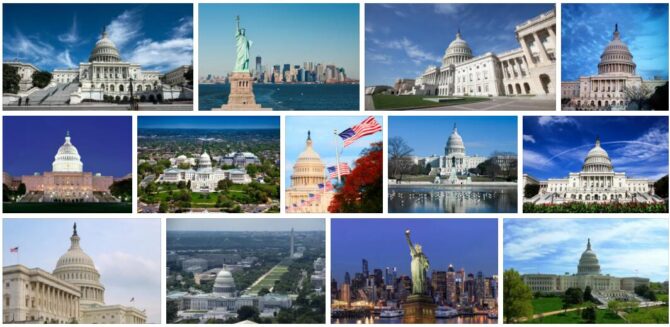
North America Relief
The North America, in general, is geologically old, even though it has more recent formations. In Canada, for example, rocks of 3.96 billion years are found, which are among the oldest on the planet.
In the subcontinent there is the presence of crystalline and metamorphic plateaus, which were lowered by the action of weathering agents, and extensive sedimentary plains located between the plateaus and the Rocky Mountains. The areas of ancient plateaus occur along the Atlantic coast, represented by the Laurentian Plateau, in Canada, and the Appalachian Mountains, in the United States. These regions are rich in ferrous mineral resources, such as iron and manganese.
The formation of the Appalachian Mountains occurred about 400 million years ago, in the Devonian period. Over time, the region was divided by rivers and glacial actions, creating a large belt of plateaus and low mountains. Like the Appalachian Plateau, the Labrador Plateau is also formed by crystalline shields of the same age. This time provided sufficient wear and tear to form plains in the central areas, with many lakes originating from the melting of the last glacial periods.
The deepening of the excavation of the famous Grand Canyon was caused by the melting water and therefore also has its origin in the glaciation that occurred 10,000 years ago. The erosion of the Grand Canyon has been occurring since the Precambrian period. In relation to the erosive processes that shape the North American relief, the Colorado River also stands out, which excavated almost two thousand meters and exposed rocks of more than 2 billion years old.
Between the northwest of Canada and the state of New Mexico, in the United States, the Rocky Mountains are located, where it is possible to observe the formation of parallel mountain ranges, forming high plateaus and deep valleys. This set of higher lands defines the great hydrographic basins of the United States and Canada. The Rocky Mountains are a geologically recent formation, formed by the movement of tectonic plates along the Pacific coast, with peaks that reach up to four thousand meters in altitude. Its highest point is Mount Elbert, with 4,399m.
Regarding the Rocky Mountains, many geologists point out that added to the mountains of Alaska and the set of Mexican Sierras Madres, they are part of the same geological extension – which could be a continuous mountain range connected to the South American Andes, were it not for the existing crack in Panama that intersperses high altitudes. The highest peak in North America is Mount Denali, at 6,194m.
Further south, the Mexican Plateau draws attention due to its size, occupying a quarter of the country’s territory. Nestled between the majestic Sierra Madre Oriental and Sierra Madre Oeste, the plateau is an extension of the great plains north of the subcontinent. It is located at more than 1,000m altitude and advances along 1,800km, from the coast of the Rio Bravo, on the border with the United States.
The relief of Mexico, predominantly mountainous, is characterized by being rugged and the presence of many volcanoes. Sierra Madre Oriental and Sierra Madre Occidental cross Mexico territory from north to south. The Sierra Madre Occidental ends in Nayarit, meeting the Sierra Madre do Sul. In the border between them is the Neovulcanic Axis, which crosses the territory from east to west, joining the Sierra Madre Oriental in the Serra Mixteca, at 3,395 meters of altitude. In this axis, of great volcanic activity, are the highest points of Mexico: the Pico de Orizaba (5,610m), Popocatépetl (5,462m), Iztaccíhuatl (5,286m), among others. The extensions to the southeast of the Sierra Madre Oriental are known as Sierra Madre de Oaxaca and Sierra Madre de Chiapas.
Central American Population
With a population of about 45 million and a territory of approximately 522,760 km², Central America has a population density of 102 residents/km² (According to Countryaah.com, Barbados has the largest, 674 residents/km², and Belize the smallest, 15 residents/km²). The subcontinent is divided into two parts: the island portion, formed by the islands known as the Antilles; and the isthmic (or continental) portion, a strip of land that connects, in the American continent, between North and South America.
The Central American population is divided evenly between the two parts of the territory, with approximately half of the people living in each of them.
The independent countries located in the continental portion (such as Guatemala and Nicaragua) have undergone a majority Spanish colonization, which defined characteristics in common predominant for the population from the Hispanic American culture, such as the Catholic religion and the Spanish language – although there are also very popular indigenous languages, such as Mayo-Zoque and Miskito-Matagalpa. The colonization process also contributed to the great miscegenation that occurred in these countries. In a generalization of the ethnic composition, it is understood that the region inhabited by descendants of the Amerindian peoples (Aztecs, Mayans, chibchas, among others), mestizos (miscegenation of Indians with whites), whites of mainly Hispanic origin, and blacks. Visit Allcitycodes.com for area codes and capital cities of countries in North America.
| Country | Number of residents per square kilometer | Proportion of residents in the cities (percent) |
| Antigua and Barbuda | 219 (2018) | 24.7 (2017) |
| Bahamas | 39 (2018) | 82.9 (2017) |
| Barbados | 667 (2018) | 31.2 (2017) |
| Belize | 17 (2018) | 45.6 (2017) |
| Costa Rica | 98 (2018) | 78.6 (2017) |
| Dominica | 96 (2018) | 70.2 (2017) |
| Dominican Republic | 220 (2018) | 80.3 (2017) |
| El Salvador | 310 (2018) | 71.3 (2017) |
| Grenada | 328 (2018) | 36.2 (2017) |
| Guatemala | 153 (2018) | 50.7 (2017) |
| Haiti | 404 (2018) | 54.3 (2017) |
| Honduras | 86 (2018) | 56.5 (2017) |
| Jamaica | 271 (2018) | 55.4 (2017) |
| Canada | 4 (2018) | 81.4 (2017) |
| Cuba | 109 (2018) | 77.0 (2017) |
| Mexico | 65 (2018) | 79.9 (2017) |
| Nicaragua | 54 (2018) | 58.3 (2017) |
| Panama | 56 (2018) | 67.4 (2017) |
| Saint Kitts & Nevis | 202 (2018) | 30.8 (2017) |
| Saint Lucia | 298 (2018) | 18.6 (2017) |
| St. Vincent & the Grenadines | 283 (2018) | 51.8 (2017) |
| Trinidad & Tobago | 271 (2018) | 53.2 (2017) |
| USA | 36 (2018) | 82.1 (2017) |
The island part, in turn, is divided into large Antilles and small Antilles and was colonized by French, English, Spanish and Dutch. The Greater Antilles are the largest islands in the Caribbean and include the countries: Cuba, Dominican Republic, Jamaica and Haiti. The Lesser Antilles are several smaller islands in the Caribbean Sea, which constitute small overseas countries and territories, such as: Barbados, Granada, Trinidad and Tobago, among many others – some of which are dependent on other countries. Due to the colonialist race that occurred in the region, there is a great diversity of cultural and human traits. In this region, the presence of a black population is more marked, due to the past of intense use of slave labor in these countries. They complement the composition of the population, in general, mestizos (who are the majority), whites of varied origins and indigenous people (in low numbers). The languages in these countries are diverse, as colonization occurred. Spanish, French, English, Dutch, Haitian Creole and many others are spoken. As in all of Central America, the Catholic population predominates on the islands.
The Central American economy still suffers from the colonial heritage, still maintaining primary activity as the main economic engine. Agriculture and extractivism are mainly responsible for employing most of the labor force.
Originating in the colonial past of exploration, structures of internal and external domination still survive throughout the subcontinent, characterizing underdevelopment. The social inequalityit is striking and deprives a large part of the population of services and basic needs to obtain better living conditions. Haiti, for example, is among the countries with the worst economic and social indicators in the world, with a life expectancy of less than 50 years of age, infant mortality of around 63.2 per thousand births and 80% of its population living below the poverty line. In terms of human development indices, Cuba is the country that stands out in Central America, with the lowest birth rates (1.5%) and infant mortality (7 per thousand births) in the subcontinent, in addition to the high expectation of life (76.7 years). Cuba is also the second country with the largest population (11.3 million inhabitants). The first is Guatemala, with 14 647,083 inhabitants. The most urbanized countries in Central America are Bahamas (89%) and Trinidad and Tobago (74%). The least urbanized are São Cristovão and Névis (34%) and Haiti (36%).
